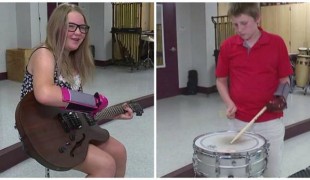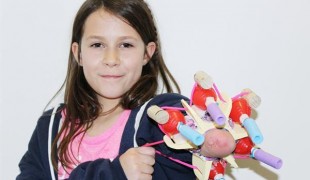- 2293
- 124
- 0
- 0
- 0
- Help Ukraine
About the solution
Juan and his sister Andrea Monroy launched a brand new online marketplace for 3D design and 3D printing called 3Dglück, which aims to provide 3D creation services to people across Latin America. Diego, a rock n roll lover, was born with a congenital amputation of his right hand.
The boy used other prosthesis as a child, but they never worked very well for him. They tended to break, be uncomfortable or featured a mechanical grip that was hardly worth all the trouble, and by the age of eight he decided that he didn’t want to have a replacement for his hand anymore.
That all changed when Diego met Juan. The designer thought 3D printing would be the best solution. “After talking to him and his family Juan Camilo understood their frustration and the fact that most of the time prosthesis are not exactly made to meet the needs of a specific person," Andrea said.
Diego was only interested in a prosthetic hand that would allow him to do different things, in his case, to play guitar.
“There is a quote by Louis Borges that says “I am not who I am, I am what I do with my hands”, that is exactly the way Diego perceives life. Why would someone want an expensive prosthesis if they cannot do extraordinary things like playing piano, guitar or take a picture? Why is the main goal covering the problem?", Andrea said.
Playing the guitar requires very exact motions and pressures on the muscles and cartilage of the human hand, so there’s a lot more to it than adding a pick to a plastic prosthetic. They therefore heavily relied on a book by Adalbert Ibrahim Kapandji on human physiology, "The Physiology of the Joints volume 6", which describes the detailed pronation and supination movements of playing a guitar. With this knowledge, they developed six prototypes, eventually adding a series of springs that enable the necessary pick movements.
So, the result was a different 3D printed hand, with only two “fingers”. It is worn with a non-skid fabric underneath to ensure a secure fit, and can be controlled using the pronation and supination movements of the arm.
The prosthesis had a total cost $300. And now Diego can play guitar.
Adapted from: http://www.3ders.org/articles/20150202-17-year-old-learns-to-play-the-gu...
More info: https://twitter.com/3dgluck
https://www.youtube.com/watch?v=8hRzhBmO9iA
This solution shall not include mention to the use of drugs, chemicals or biologicals (including food); invasive devices; offensive, commercial or inherently dangerous content. This solution was not medically validated. Proceed with caution! If you have any doubts, please consult with a health professional.
DISCLAIMER: This story was written by someone who is not the author of the solution, therefore please be advised that, although it was written with the utmost respect for the innovation and the innovator, there can be some incorrect statements. If you find any errors please contact the patient Innovation team via info@patient-innovation.com
-
-
383
-
0
-
7052

Teenager invents 3D prosthetics to help friends play instruments
-
-
-
434
-
0
-
7346

Girl invents way to get new attachments for her 3D printed arm
Grip
Limb Deformity
Hand Deformity
Elbow Deformity
Prosthesis
3d Printed
Body-Worn solutions (Clothing, accessories, shoes, sensors...)
Assistive Daily Life Device (to help ADL)
Muscle weakness
Limited range of motion
Reduced grip force (grip)
Loss of muscle coordination
Restoring mobility
Replacing lost limbs
Maintaining Balance and Mobility
General and Family Medicine
Medical Genetics
Pediatrics
United States
-
-
-
544
-
0
-
9063

Azai Bionic Arm
-
 en
en